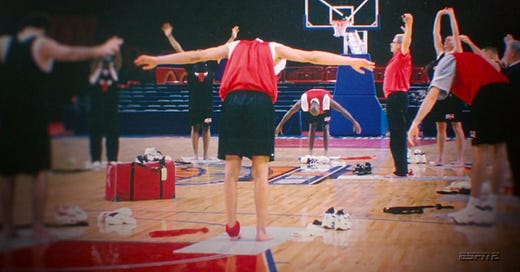#247: Mind Calming Strategies for Our Youth
Teaching mindfulness techniques maybe the most important lesson a coach or parent can accommodate.
Every generation grows up with its own list of stressors. We had them back in the day, and our kids have them today. The only thing in common from generation to generation is that they are often different. Meaning no two generations have the same challenges. It makes it difficult as adults to relate to the challenges of today’s youth. To be able to do so requires empathy and perspective beyond our own experiences.
When we think of the biggest challenges with our youth today, mental health immediately comes to mind. One of the telltale signs of today’s issues is the lack of downtime in our kids lives. When I say downtime, I refer to time without being in front of a screen, time when the brain is not being called to do something. Being comfortable in silence often seems non-existent. The constant need for stimulation is real, whether it be watching shows, video games or the dopamine hit from social media.
In the 1970’s and 80’s, meditation or mindfulness was reserved for that group that practiced yoga or Buddhism or a seemingly faraway practice not relatable to our western culture. How much of a mistake that perception was is a good topic for another day.
That perception started to change years ago in reading Sacred Hoops by Phil Jackson. Coach Jackson is on the best basketball coaches and experts of all time, having played or coached on 11 championship professional teams in the NBA.
In the 1995 book, Coach Jackson writes about how critical a clear mind is to performance. The ability to “not think” during performance being the gateway to good performance. He writes about how even the best players struggle with mastering the idea of a clear mind. Specifically, Jackson says that many players tend to struggle with their composure after a certain point as the level of competition rises, because their minds start racing out of control. To help players quiet the mind he practiced, taught and recommended mediation and specifically mindfulness. The idea is to find stillness within the meditation. This stillness allows us to be engaged in the moment without getting overwhelmed.
When we think of the above premise from Coach Jackson, do we see the application to today’s youth?
The challenge of clearing the mind?
A constant challenge to keep our thoughts from spiraling to places that are not so healthy?
Or even just giving our brains time to recharge?
Our kids' brains are tired, and children of all ages really need to know how to create to opportunities where they can take time out each day "unplugged" to relax and focus. Meditation offers this break and helps kids function more effectively and clearly.
The development of the skills of calming the mind, thus becomes a critical skill not only for performance on the field of play, but also off the field in the game of life as well.
With the right approach, parents and coaches can teach meditation for kids to help them understand how to calm their minds and settle into their bodies, allowing them to better process their feelings, retain new information, and improve focus — and do that much quicker than we think.
The simple act of teaching children how to stop, focus, and just breathe could be one of the greatest gifts we give them. The start maybe to practice meditation ourselves.
How meditation helps ADHD
Meditation tips
Meditation does not have a set of rules, but there are some tips that can help.
The length of time and frequency of meditating can vary for different people and different practices. But, pediatricians typically recommend the following time frames:
· Grade school children: 3-10 minutes twice a day.
· Teens and adults: 5-45 minutes per day or more based on preference.
Try incorporating deep breathing into pre-practice or pre-game routines. It can help them prepare for the activity, remove the thoughts outside of the activity and make meditation easier to do when other situations arise.
Remind our youth to take a few deep breaths before answering a difficult question at school, taking a test, or before an athletic performance.
As young children learn to manage strong emotions, deep breathing can be part of the process—especially during breaks or when they feel their mind getting “busy”.
There are multiple ways to learn different practices of meditation. There are books, videos, online training, websites and smartphone apps to help children meditate. Choose and practice the one that works the best for you and your child, and enjoy a calmer body, mind and spirit.
Additional research:
Navigate the emotional roller coaster of adolescence, better focus, communicate in a kinder way?
The below research shines light on these topics:
https://www.tandfonline.com/doi/abs/10.1080/1754730X.2009.9715696
https://ijsser.org/files_2019/ijsser_04__337.pdf
https://www.frontiersin.org/journals/psychology/articles/10.3389/fpsyg.2018.02162/full




